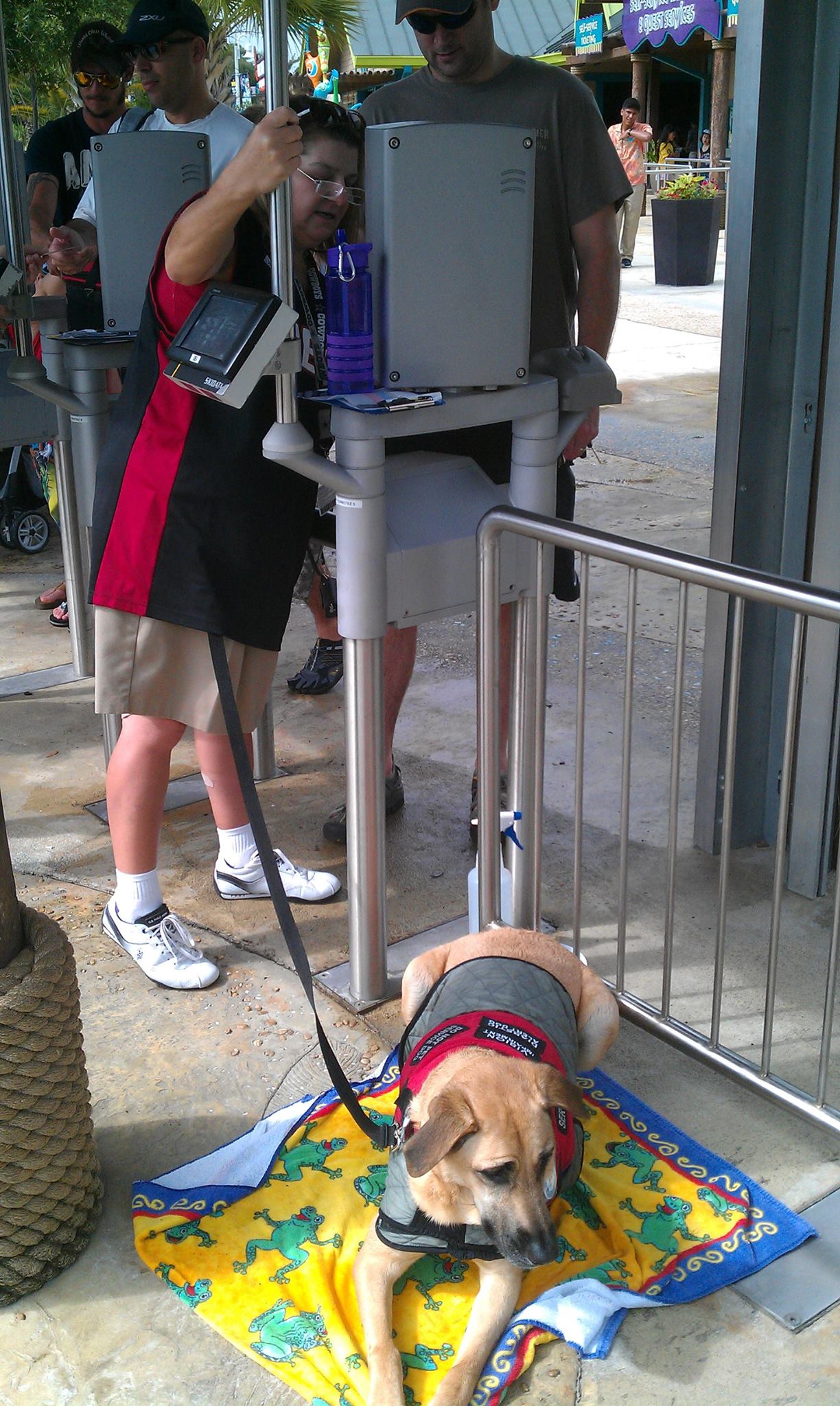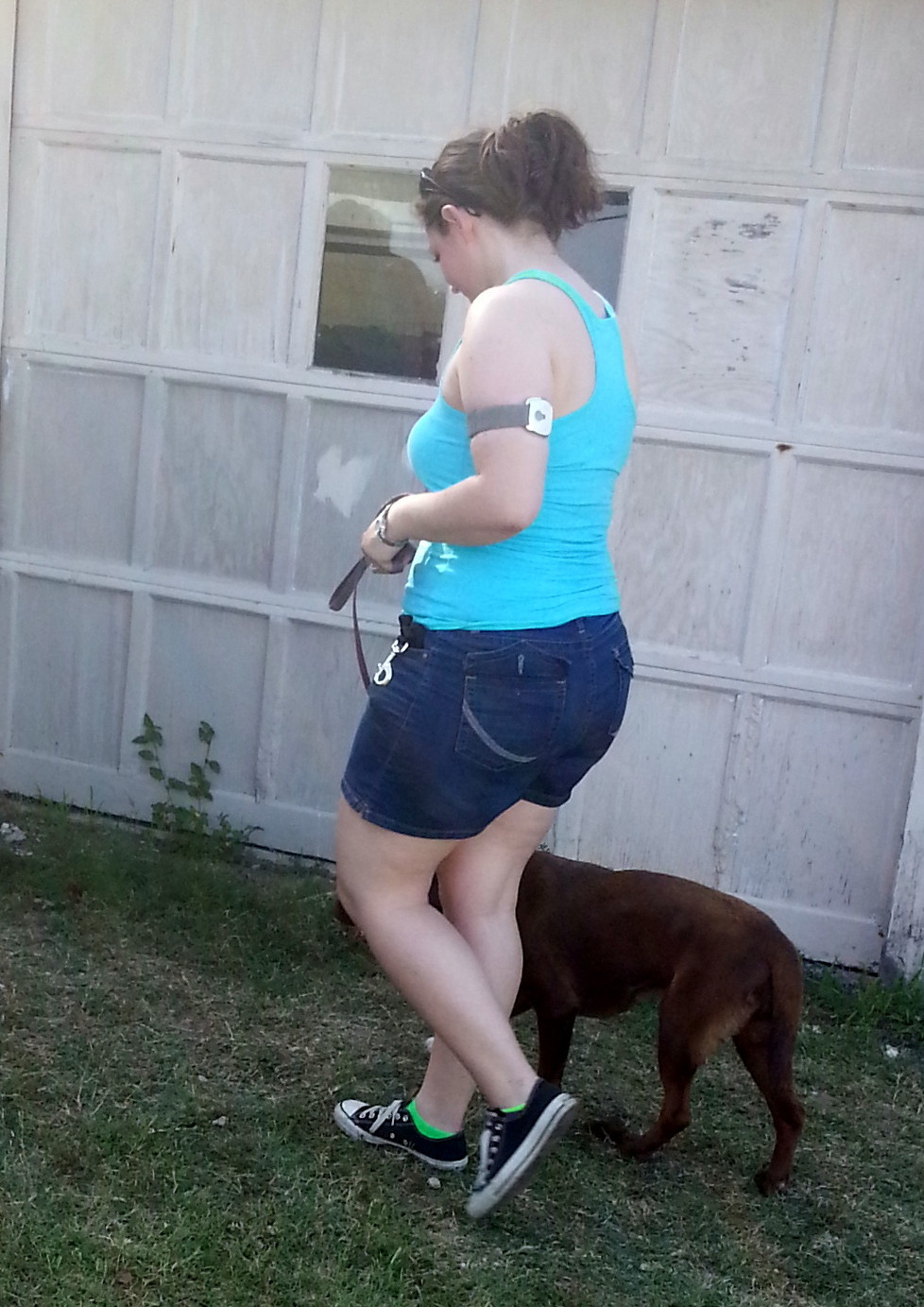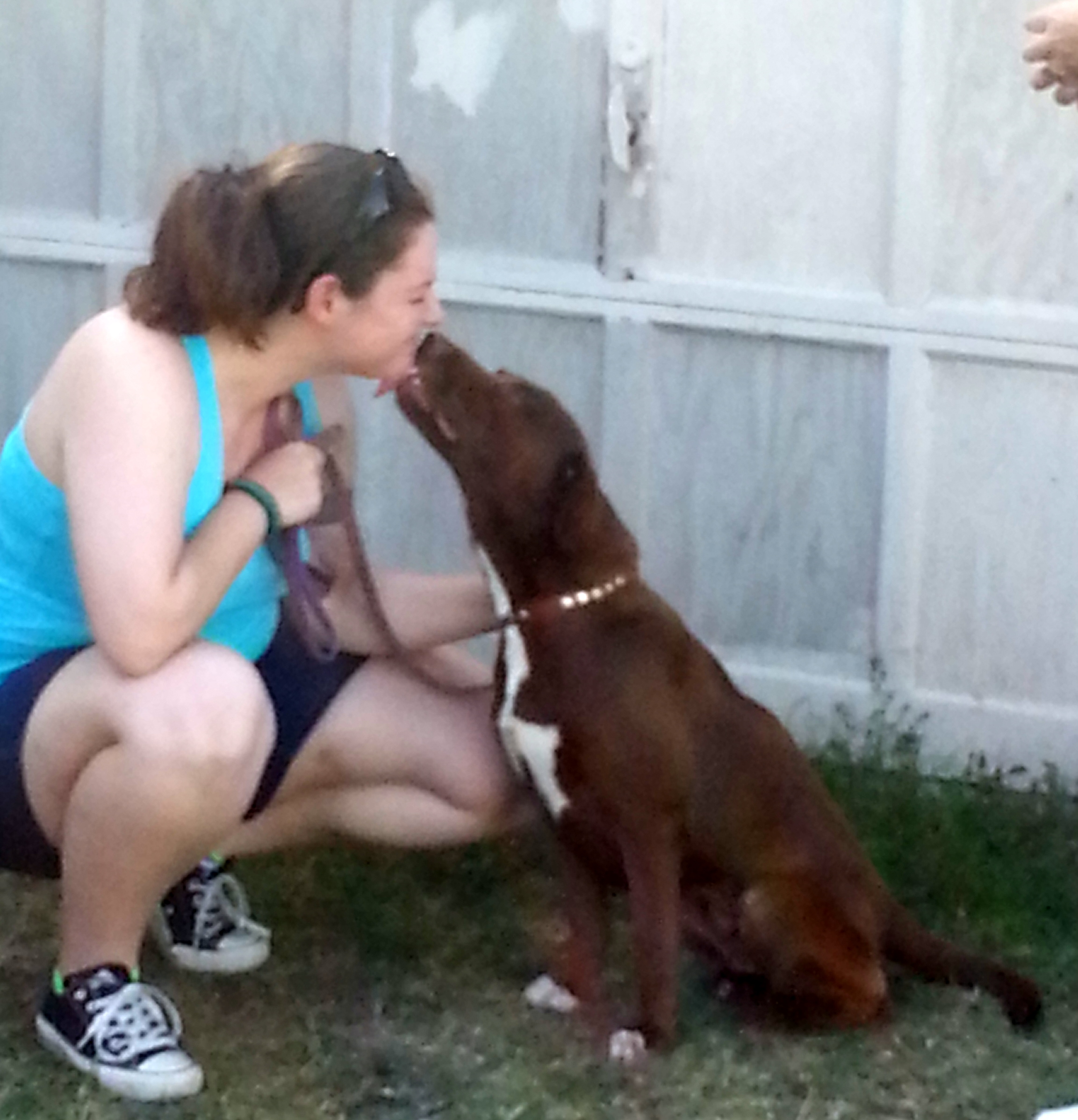“Noah prepping to protect me for the 4th of July. He does realize he’s not a small puppy any more!”

“Noah prepping to protect me for the 4th of July. He does realize he’s not a small puppy any more!”

A friend sent this rather shocking message:
“So, I went to the post office today next to Central Market. There was a sign on the door that said “No Dogs, other than Seeing Eye Dogs”. Do you think that Service Dogs are allowed in there? I would think that it would be illegal for them to discriminate on the type of Service Dog allowed.”
4801 Broadway St
San Antonio, TX 78209
Phone number (210) 826-0230
GUESS WHO’S GETTING A PHONE CALL TOMORROW?! HOW UTTERLY ABSURD. I HAVE AN IDEA THIS IS GOING TO TAKE SOME TIME.

Look at this wonderful picture!!! There is Tyler, who suffers from epilepsy, with his SD, Destiny!!! They are on the right, if you have trouble distinguishing a dog from a swimmer!! Tee hee. Taylor and Destiny are training twice a week together – and it’s going great, according to his mother!!! SO proud of you Tyler, Destiny, and mom Jo!!!
The two most commonly seen and available head halters in the USA are the “Gentle Leader” (GL) and the “Halti”. They each have their advantages and disadvantages. The general premise is that they work like a horse’s halter. If you can control the head, you can control the body. Some dogs are very resistant to them (often the ones that
would benefit the most) and some accept them with little adjustment period. You can increase your chances of success by introducing the halter in a slow and positive manner.
Gentle Leader:
Manufactured by Premier Pet  Products, they were formerly only available from trainers and vets, but are now available in many retail places. They come in various sizes and colors, but I suggest choosing a color that closely matches your dog’s face.
Products, they were formerly only available from trainers and vets, but are now available in many retail places. They come in various sizes and colors, but I suggest choosing a color that closely matches your dog’s face.
Description:
Two “loops” that connect below the chin at the throat. The “neck loop” fits like a collar high on the neck just behind the ears. The fit is quite snug. The “nose loop” goes over the dog’s nose and rests just in front of the eyes. It is adjusted fairly snugly so that the loop won’t slide off the end of the dog’s nose. There is a ring at the bottom where the two loops connect. This is where the leash attaches.
Advantages:
Well made. Nice feeling fabric. Choice of quick release or buckle. A second ring on the neck loop allows you to use it as a collar (nose loop hangs loose at throat rather than over nose) in transitioning off of using the GL. For dogs that accept it readily, the owner can be walking the dog in a matter of minutes. It doesn’t require much training for owners to get started.
Disadvantages:
Snug fit is fairly restrictive. Some dogs find this objectionable. Generally costs more than the Halti. The position of the leash attachment gives less control than that of the Halti.
 Halti:
Halti:
Created by Dr. Roger Mugford and manufactured by Coastal. They are available in many pet supply stores and catalogs. They come in a variety of sizes, originally only in black, but some colors are now available. If you choose a color, choose one that blends with your dog’s face.
Description:
One piece design has cheek straps that connect the nose loop and neck loop portions. Newer models may have some adjustment options. Leash connects to a ring that is located on the bottom under the dog’s chin. All have quick release connectors. Fit should allow a finger to easily slide under both cheek straps.
Advantages:
Looser fit and lighter weight fabric is less restrictive and better accepted by some dogs. Location of the chin ring gives better leverage… easier to turn the dog’s head without twisting the neck. Less expensive and may be easier to find than the GL.
Disadvantages:
Feels a bit flimsier to the touch. Looser fit means that the dog can paw it off or back out of it easier. It is recommended that a back-up leash or collar be used for safety and the Halti now comes with a short safety strap to attach it to the collar. Lack of adjustment means it may not fit all head shapes.
A lovely update from Melanie, with SD Roxy. Melanie works at Sea World, San Antonio, and Roxy goes to work with her every day. She thought we might enjoy seeing Roxy at work!

 Good information about travelling with your Service Dog and TSA questions and concerns about airport security checkpoint screening for travelers with disabilities and medical conditions.
Good information about travelling with your Service Dog and TSA questions and concerns about airport security checkpoint screening for travelers with disabilities and medical conditions.
If a passenger has a service dog due to a disability or medical condition, both the passenger and the dog will be screened. The passenger should inform a Transportation Security Officer (TSO) that the dog is a service animal and not a pet, and the TSA recommends that passengers have documentation or that the dog wear gear (a harness, vest, etc.) to indicate that it is a service animal.
Passengers are expected to maintain control of their animals by holding onto the leash throughout the screening process, and they should not be separated from their dogs by TSA personnel.
Passengers with service dogs will be screened either by a walk-through metal detector or thorough patdown. If the passenger and service animal are screened by a walk-through metal detector, they can proceed in one of three ways:
• The passenger can walk through first with the dog following behind on its leash.
• The dog can walk through first on its leash with the passenger following behind.
• The passenger and dog can walk through at the same time.
If a passenger and the dog walk through at the same time and the metal detector alarms, both the passenger and dog are subject to additional screening, including a thorough patdown. If the passenger and dog walk through separately, only the party that alarms the metal detector will receive additional screening. It is very important that the passenger not make contact with the dog (other than holding the leash) until the dog has been cleared and inspected by a TSO.
If a patdown is required in order to complete screening:
• The patdown should be conducted by a TSO of the same gender. Sometimes, passengers must wait for a TSO of the same gender to become available.
• The passenger can request a private screening at any time and a private screening should be offered when the TSO must patdown sensitive areas. During a private screening, another TSA employee will also be present and the passenger may be accompanied by a companion of his or her choosing.
• A passenger may ask for a chair if he or she needs to sit down.
• The passenger should inform TSOs of any difficulty raising his or her arms, remaining in the position required for a patdown, or any areas of the body that are painful when touched.
• A passenger should not be asked to remove or lift any article of clothing to reveal a sensitive body area.
In addition to the patdown, TSA may use technology to test for traces of explosive material. If explosive material is detected, the passenger will have to undergo additional screening. For more information about the technology used to test for traces of explosive material, please visit http://www.tsa.gov/…/
Regardless of how the passenger and dog proceed through the walk-through metal detector, the dog will receive additional screening. A TSO will physically inspect the dog and the dog’s belongings (collar, harness, leash, backpack, vest, etc.) in order to resolve the alarm. Although the dog’s harness will not be removed, it and other items that he or she may be carrying, such as a backpack, are subject to screening.
If a passenger leaves the secure side of the airport to relieve his or her dog, the passenger and dog will need to undergo the screening process again. When a passenger returns to the security checkpoint, he or she may ask to move to the front of the screening line.
Medication for service animals is permitted through security checkpoints once it has undergone x-ray or a visual inspection. All liquids, gels, or aerosols that exceed 3.4 ounces will receive additional screening. Passengers should tell TSOs in advance if there are medically necessary liquids for the service dog that need to be screened, and these should be separated from other items in the passenger’s carry-on.
A companion, assistant, or family member may accompany a passenger to assist him or her during any private or public screening. After providing this assistance, the companion, assistant, or family member will need to be rescreened. The passenger should inform the TSO of his or her need for assistance before the screening process begins.
If a passenger has concerns about his or her screening, he or she should ask to speak with a supervisor or Passenger Support Specialist while at the checkpoint. Passengers also can report concerns by contacting TSA’s Disability and Multicultural Division at [email protected] or
Transportation Security Administration
Disability and Multicultural Division
601 South 12th Street
Arlington, VA 20598
TSA encourages passengers with disabilities or medical conditions to arrive at the airport early and to visit www.tsa.gov for more information before they fly.
A Wounded Warrior tried to enter the CSL Plasma Donation Center on Marbach with his Service Dog. I have spoken to the manager at this Center before, and it was decided that due to contamination issues, Service Dogs are allowed in the front, but not in the back where the actual plasma is being donated. I received a message from this client yesterday, explaining that he tried to enter, and although he understood that the dog could not go to the back, he was with his girlfriend who would hold the Service Dog up front. He was treated with extreme disrespect, yelled at and humiliated in front of other clients, and despite holding his calm demeanor and presenting his ADA SD rights card, was treated so badly that he went back to his car and broke down. I emailed and called the donation center today, and they apologized profusely for the behavior of their worker, and will be sure to contact our client asap to apologize.
“I am a Service Dog trainer in San Antonio, TX. One of your regular donors, Mr. XXX, a Wounded Warrior who fought in Afghanistan, tried to enter his local CSL Plasma center on 8725 Marbach Rd #275, San Antonio, TX 78227 with his Service Dog. While I understand that Service Dogs may be denied entrance to plasma donation center back rooms due to contamination issues, the way my client was treated was extremely harassing, humiliating, degrading, and ultimately against the law. My client was too upset to call the police, but had he done so, the woman who harassed him would have opened your establishment subject to a lawsuit. Harassment of a Service Dog is a misdemeanor, as is harassment of a Service Dog owner. This occurred at 4:45 on June 15th. My client would like an apology from not only the manager but directly from the woman who harassed him. I have put a call into the location and expect to hear back immediately. Again, I understand the contamination issues, but the humiliation my client received was completely uncalled for.”
Let’s hope they apologize. I applaud this Wounded Warrior for maintaining his calm demeanor while explaining his rights.
 Today was a great day for Kelsie who had a love at first sight meeting with Chocolate lab mix, Choxi!
Today was a great day for Kelsie who had a love at first sight meeting with Chocolate lab mix, Choxi!
Choxi showed off her perfect heel and showered Kelsie with kisses!
Sweet Choxi will be accompanying Kelsie to work with her, Kelsie is a Chaplain at a hospital and is studying to be a Pastor. Kelsie has the full support of the hospital staff.
Choxi’s tasks will be to calm her when she is anxious, lay on her when she needs to lay down with a cuddle, and alert her out of bad dreams.
It is obvious that Choxi and Kelsie make an awesome pair, I am so looking forward to doing more training with them next week. Choxi was rescued from Animal control just hours before she was due to be euthanized. She is now going to change the life of a very deserving and charming young lady